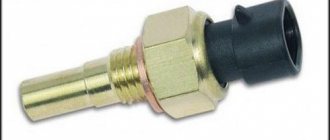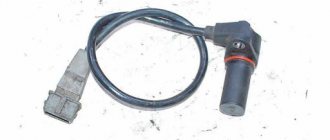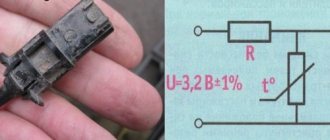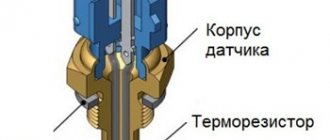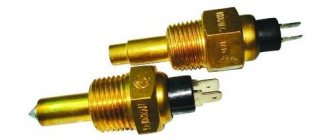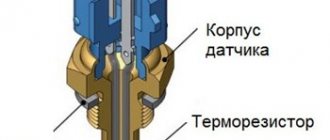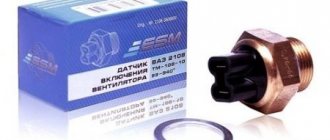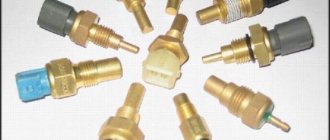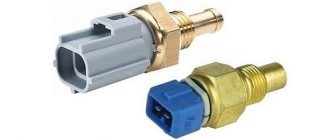What happens if the temperature sensor on a VAZ 2114 does not work? The engine may boil. You are going on vacation outside the city, or to visit your grandmother in the village, or you are stuck in a traffic jam for many hours - in any case, there is a risk of the engine overheating. To recognize this possibility in time, you need to look at the coolant temperature gauge - a special sensor. And it directly depends on the signal that is transmitted from another sensor - a meter for this very temperature. Unfortunately, on any VAZ, including the fourteenth, it is unreliable. Even more sad is the fact of its factory unreliability - they do not always produce a high-quality product in the Russian automobile industry.
Location of DTOZH
There are 3 types of cooling system: liquid, air, mixed. The VAZ is equipped with the first type of cooling - based on coolant: antifreeze or antifreeze. The system itself consists of the following elements: cooling radiator, radiator fan, heating radiator, cooling system jackets, pump, expansion tank, connection pipes, DTOZH (identical in design to a sensor from tens).
DTOZH VAZ 2114 (coolant temperature sensor) is located in the gap between the thermostat and the cylinder head, on the cooling system pipe, connected to the system by two wires. It is often confused with the one that has one contact and is located on the dashboard. The design of the DTOZH consists of a resistor, the resistance value of which directly depends on the heating of the engine.
The VAZ 2114 coolant temperature sensor is located on the engine block itself, not on the radiator, like other VAZs. Don’t look for it there in vain; in the same way, you shouldn’t correlate breakdowns of the temperature meter on the fourteenth and eight: the manufacturer is the same, but the circuits are different.
5) Dirty radiator
If your car has driven more than 80 thousand km, then most likely the cooling radiator is very dirty, which can also cause the engine to overheat.
See also: Five types of fluids that need to be checked in a car
In order to avoid this, it is necessary to flush the radiator every year. It is advisable that, along with cleaning the radiator, the coolant itself is changed. Despite the fact that the manufacturer itself recommends changing antifreeze every 3 years, we, for our part, strongly recommend changing this coolant every year.
In conclusion, dear readers, we would like to once again remind all car enthusiasts that in addition to regularly checking the entire cooling system (especially before a long trip), it is necessary to periodically conduct a complete diagnostic of the operation of all the most important systems of the car. Don't forget to regularly check the oil level in your car engine. Remember that by maintaining the engine oil level at optimal values, you reduce the load on the engine itself and thereby prevent unnecessary overheating (heating) of the engine in advance.
The lower the load on the engine, the longer the service life of the vehicle's power unit. Good luck to you friends!
About DTOZh breakdowns
- no contact with the sensor;
- loss of insulation, broken contacts;
- device failure;
- the fan does not work systemically.
- the engine is not even warmed up yet, but the fan is already running;
- a warm engine does not want to work;
- gasoline began to be consumed more.
Before you check the coolant temperature sensor, remember, the main thing is not to confuse it with the coolant temperature gauge sensor!
Attention - air
Finally, another possible reason for sudden movements of the needle is the presence of air bubbles in the antifreeze (“airing” of the system). Since the air and antifreeze have different temperatures, the needle jerks. An indirect sign of this malfunction is the splashing of coolant from the radiator cap or expansion tank, as well as a decrease in the filling volume.
To summarize, we can suggest the following order for checking the elements: contacts, ground, temperature sensor (DTOZH), thermostat, indicator board. Owners of Renault Logan should not dramatize the 2-4-2 display. This is normal thermostat operation.
PS In order not to upset Logan drivers, on the Duster and the second generation Logan-Sandero the temperature indicator on the dashboard was completely removed. As they say: no pointer, no problem.
Checking the DTOZH
DTOZH transmits a signal to the dashboard, which shows the driver the level of antifreeze heating.
How to check the temperature sensor on a VAZ 2114:
- We start the car, look at the instrument panel, the arrow points to the maximum, and the engine is cold as ice, we disconnect the contacts from the temperature meter: the arrow has dropped to a minimum - it’s time to replace it.
- If the arrow remains at the maximum, look at the DTOZH contact, it may be shorted to the car’s ground.
- The engine warms up normally, but the needle jumps or lies at zero - check the fuses.
- If the fuses are normal, close the contact to the ground of the car - the arrow jumps up - the temperature sensor on the VAZ 2114 does not work.
Another great method:
- Take a multimeter and set it to ohmmeter mode.
- You also need a good thermometer with a maximum of over one hundred degrees and a container that can withstand hot antifreeze.
- We attach the multimeter probes to the body and the sensor terminal.
- Place the connected DTOZH in a container with poured antifreeze or antifreeze and heat it up.
- We look at the indicators of the thermometer and ohmmeter:
| Temperature, C | Resistance, Ohm |
| 30 | 1350-1880 |
| 50 | 585-820 |
| 70 | 280-390 |
| 90 | 155-196 |
| 110 | 87-109 |
These are indicators of the working sensor. The good thing about this method is that you can also check a new one, which you can’t always get in working order.
How to remove the coolant temperature gauge sensor?
Before removing the coolant sensor, remove the air filter, it will interfere with its unscrewing. And first of all, drain the antifreeze (antifreeze). We will merge as follows:
- The engine must be cool.
- You will need spanners for 8, 13, 17.
- Prepare a container for the coolant to drain!
- We remove the engine protection, use a wrench to unscrew the radiator mounts
- We set the heater to maximum, then open the heater tap and the cap of the expansion tank.
- We place the container under the radiator and SLOWLY (if you do it quickly, you will flood the generator) unscrew the drain plug.
- Let him run away for about 10 minutes.
- Let's move on to the engine itself: similarly, we place the container under it and unscrew the plug (under the ignition module) on the cylinder block.
- Let it flow again for 10 minutes.
Before closing all the plugs, wipe the neck of each of the holes!
We remember where the coolant temperature sensor is located on the VAZ 2114, and begin to remove it:
- found it, removed the protective rubber layer;
- we look at the body, look for the markings (on one of its 6-sided parts), remember it, so that later we can put everything in accordance with the system;
- unscrew the meter with the twenty-first key;
- install a new one.
Why the temperature arrow goes off scale - the main reasons!
The normal operating temperature of the engine on the instrument panel is 90 degrees. The arrow indicates the red zone of engine overheating. Learn more about the situation when the instrument panel does not show the engine temperature.
You can find out why the malfunction occurred in your garage, and you don’t have to go to a car service center. But to fix the problem, you may need outside help from professionals.
So, let's look at the main reasons why the temperature arrow on the VAZ-2114 dashboard goes up:
- Dashboard diagram.
- Temperature sensor.
- Wiring harness.
- ECU.
Solution methods
When the reasons are identified, you can proceed directly to eliminating them and consider the issue in more detail. So, to begin with, it is worth noting that the motorist will need some knowledge of the design features of the car, as well as knowledge of the electrical part.
Dashboard diagram
Dashboard board
The first place to look for a problem is the dashboard. In order to eliminate the malfunction, you will have to dismantle the “tidy” and also disassemble it.
The next step is to find the motor that powers the arrow. There may be two malfunctions here. Which ones exactly:
- Due to a short circuit, the motor winding burned out.
- The wire that is soldered from the motor to the dashboard board has come unsoldered or has come off.
To eliminate this cause, it is necessary to inspect the place and determine the presence of breaks. For complete reliability, it is necessary to ring the contact wires of the motor that close the winding.
Another stage of diagnostics will be the connector that connects to the board . It is necessary to find the contact that is responsible for the temperature indicator and also ring it using a multimeter. If a connection break is detected, it must be repaired.
Attention! If a motorist does not have experience in repairing such components, it is strongly recommended to contact professional auto electricians so as not to cause even more trouble when doing the repairs yourself. They will do everything quickly and efficiently.
temperature sensor
The temperature sensor is checked with a multimeter
If the problem was not hidden in the dashboard, then you need to contact the temperature sensor directly . It is this that serves as an indicator of the engine temperature and transmits data through the computer to the needle. Failure of the product can cause a freezing effect and the needle on the dashboard going off scale.
To determine the functionality of the sensor, it must be dismantled and “ringed” using a multimeter. If it is determined to be “dead”, then it must be replaced.
Wiring harness
Disconnecting the wiring harness from the instrument panel for inspection
Cooling system problems
If you notice that the operating temperature of the VAZ 2114 engine does not correspond to the norm (both up and down), then first of all the reason should be looked for in the cooling system.
Its most important components that directly affect engine temperature are:
Thus, the first thing to check when the engine overheats is the radiator.
There are only 3 main reasons why it may not function correctly:
- Lack of coolant in the system.
- Cooling grid clogged.
- Leak.
In the first case, you should check the fluid level and, if necessary, top it up. In the second case, you will have to dismantle the radiator and clean it (both internal and external purging). In the third case (if a leak is detected), you can either use soldering or use a special sealing compound for radiators, and then add coolant to the normal level.
In some, especially advanced, cases, a complete replacement of the radiator may be required. It is not worth saving and trying to restore a “dead” radiator, since its incorrect operation can lead to severe wear and even damage to the engine, as a result of which a major repair will cost a much larger sum.
The next thing you have to check when troubleshooting is the cooling system pipes. With prolonged use, they can become “obsolete” with the further formation of cracks, which may result in a leak of coolant. If it turns out that the pipes have indeed leaked, they should simply be replaced with new ones, and the problem will be solved.
If it turns out that both the radiator and the pipes are working properly, you should check the pump (liquid pump). This can be done by replacing it with a new one of a similar model. If after such a replacement the operating temperature of the VAZ 2114 8-valve engine returns to normal, then this means that this was the reason.
conclusions
There are not many reasons why the VAZ-2114 engine temperature needle goes off scale, but all of them are quite difficult to diagnose, and some can only be eliminated in a car service center. Therefore, if the motorist has not carried out repair operations of this nature, it is necessary to contact a car service center, where they will help and repair everything.
Many drivers are well aware that constant monitoring of engine temperature allows timely detection of possible problems with the cooling system and protects the engine from overheating and costly repairs. For this reason, experienced car owners constantly pay attention to the internal combustion engine temperature indicator while driving a car.
In this article we will talk about why the engine temperature arrow rises, then the pointer drops, and also why the power plant temperature sensor may give incorrect readings, the engine temperature arrow floats while driving, etc.
Read in this article
Tips and tricks
Sometimes such non-standard behavior of the arrow can take even the most experienced drivers by surprise. But the most important thing in this situation is to behave correctly, so as not to accidentally aggravate the situation or solve it even before it occurs. Follow these tips to avoid serious consequences:
- If it was noticed that the needle is tending or is already at a high temperature level, then you should not immediately turn off the engine, but slow down (if you are in motion) and observe further changes. The temperature may normalize over time, but an emergency shutdown of the engine at a high threshold can be harmful to the engine and sensor. The only exception is when the needle is in the red zone for a long time.
- Check the amount of liquid in the tank on a regular basis in a timely manner. Don't let the level get low.
- Always monitor the quality of the liquid, both during purchase and during use. Any deviations from the norm (unpleasant odor, questionable color, etc.) must be accompanied by either diagnostics or fluid replacement.
- Keep the engine and cooling systems clean, avoid contamination and blockages.
- If the machine is very susceptible to frost, then take care that there is no internal icing, and that the machine is not left inoperative for a long time in the cold. Or use special insulation for the motor and other important parts.
If you follow these tips and be careful, you can prevent or notice problems in time, which will reduce the risk of serious breakdowns.
Also, treat such a situation with calm, this will help you better navigate, react and make decisions. So keep an eye on the needle and the engine will thank you.
The engine temperature arrow jumps, floats or jumps: causes and main malfunctions
So, normally the needle should rise to a certain value after the internal combustion engine has completely warmed up and not deviate from its occupied position. Note that during driving, small deviations are quite acceptable, and often to a lesser extent.
This phenomenon usually occurs in the cold season, often when driving on the highway. This is explained by the fact that in cold weather the engine is intensively cooled at high speed by counter flows of cold air.
Also, the heater takes away some of the heat from the engine in winter. As a result, the arrow may “fall” a little (by 2-3 mm from normal values). If you reduce the speed or allow the car to run at idle for several minutes, then the temperature gauge will rise to normal.
- First, in order to understand why the engine temperature gauge needle jumps, it should be taken into account that changing readings on the indicator do not always mean that in reality such significant changes in the temperature of the internal combustion engine occur.
In other words, a change in readings within the average range of 75-95 degrees does not reflect the actual picture, since heated coolant (antifreeze, antifreeze) cannot heat up and cool down so quickly. It turns out that the indicator does not display the actual engine temperature.
Otherwise, a smooth change in readings can be taken as the norm, making allowances for the conventional error of the dial or digital indicator itself. Moreover, if temperature fluctuations do not exceed acceptable limits, it is likely that this is the operating temperature of the engine.
A cause for concern is chaotic, usually sharp fluctuations of the needle, and the amplitude of such fluctuations is quite large. In this situation, it is necessary to determine whether there really is a violation of the thermal balance, whether the indicator itself is working normally, and also for what reasons the malfunction occurred.
- So, let's go. If the system is sealed and the coolant level in the expansion tank is normal, then the most frequently failing element, on which the engine temperature directly depends, is the cooling system thermostat. Moreover, this device often fails even on completely new cars with minimal mileage. So it’s better to start checking with the thermostat.
In practice, this manifests itself as follows: when the driver first warms up the engine, the temperature needle rises to operating temperatures, then the thermostat opens. Next, the coolant flows in a large circle, the engine temperature decreases, but then the thermostat jams and does not close completely.
Naturally, the liquid continues to flow partially or completely through the radiator (in a large circle). As a result, the engine begins to cool down and the temperature gauge drops. Then the thermostat will either close, after which the coolant will heat up to operating temperatures, or it will remain stuck in the jammed position and the engine will not warm up completely.
In this case, often after stopping the engine and the pressure in the cooling system drops, the needle will first rise to normal temperatures as it warms up, but then after the thermostat opens, everything will repeat again. There are also cases when the thermostat may not jam constantly, but every once in a while, and may not allow coolant access to a large circle.
What's the result?
As you can see, there are not many reasons for the engine temperature gauge needle on the dashboard to start jumping or jumping. However, as part of the diagnosis, you should still use an integrated approach, eliminating possible problems one by one.
Finally, we note that the main thing is to make sure that the engine really does not experience overheating or completely reaches operating temperatures. To check this, you can connect diagnostic equipment, through which you can see the real temperature of the internal combustion engine. This approach will allow you to narrow down the range of potentially problematic elements and quickly find the fault.
How to understand that the engine has begun to overheat: obvious and hidden signs of engine overheating. Common reasons why overheating occurs.
The engine temperature does not rise, the internal combustion engine temperature needle drops while driving. Why does the temperature drop after turning on the stove? Diagnostics and repair, advice.
Why does the engine overheat? What should the driver expect and what damage may occur if the engine overheats. What to do if the internal combustion engine overheats.
The engine does not reach operating temperature, the engine temperature arrow does not rise during warm-up or falls while driving: causes of the malfunction.
The engine warms up slowly at idle or while driving: why does this happen? Possible malfunctions of the cooling system, other reasons.
Causes and results of diesel engine overheating. What to do if the diesel engine is overheating: diagnostics and troubleshooting. Important recommendations.
Source
The temperature needle jumps when the thermostat and DTOZh are working
In some cases, it happens that the thermostat, as well as the temperature sensor and wiring, turn out to be working. In this case, the temperature arrow jumps arbitrarily, overestimating or underestimating the readings, in an arbitrary range.
Often the problem lies in the electronic board of the instrument panel. If the soldering of such a board turns out to be of poor quality, problems arise after a few years. The malfunction can be eliminated by disassembling the shield and re-soldering. As part of such work, special attention should be paid to resistors and output mass. If you plan to do the work yourself, you need to have a low-power soldering iron with a thin rod.
As a result, the sensor reacts to changes in temperature, the pointer arrow changes position chaotically. At the same time, the air in the system is indirectly indicated by the fact that liquid is leaking from under the cap of the expansion tank, there may be a noticeable decrease in the level in the tank, etc.
I have contact
As electricians say, there can only be two faults: there is no contact where needed, or there is contact where it is not needed. This rule also applies in the situation under consideration. The arrow will jump if the joints are oxidized or weakened. Moreover, most often this happens when additional consumers are connected: low beam, headlights, etc.
As mentioned above, the first thing to do when diagnosing DTOZH is to check the contact in the connector. Returning to the previous section, the following should be added: if the sensor malfunctions, the readings fluctuate within the same range, and if they change chaotically, the wiring may be damaged. How important the negative contact is - the mass - will be confirmed by one case described by a forum participant.
The gauge needle sometimes jumped to 130°C. After stopping the engine, it showed the correct result - 90°. The voltage at the battery terminals when the engine was not running was about 12.5 V, and after starting it rose to 13.7.
After a year and a half of unsuccessfully searching for the cause, replacing the battery, alternator and two temperature sensors, I came across one grandpa who installed an additional ground wire from the engine to the body, and the problem was solved.
